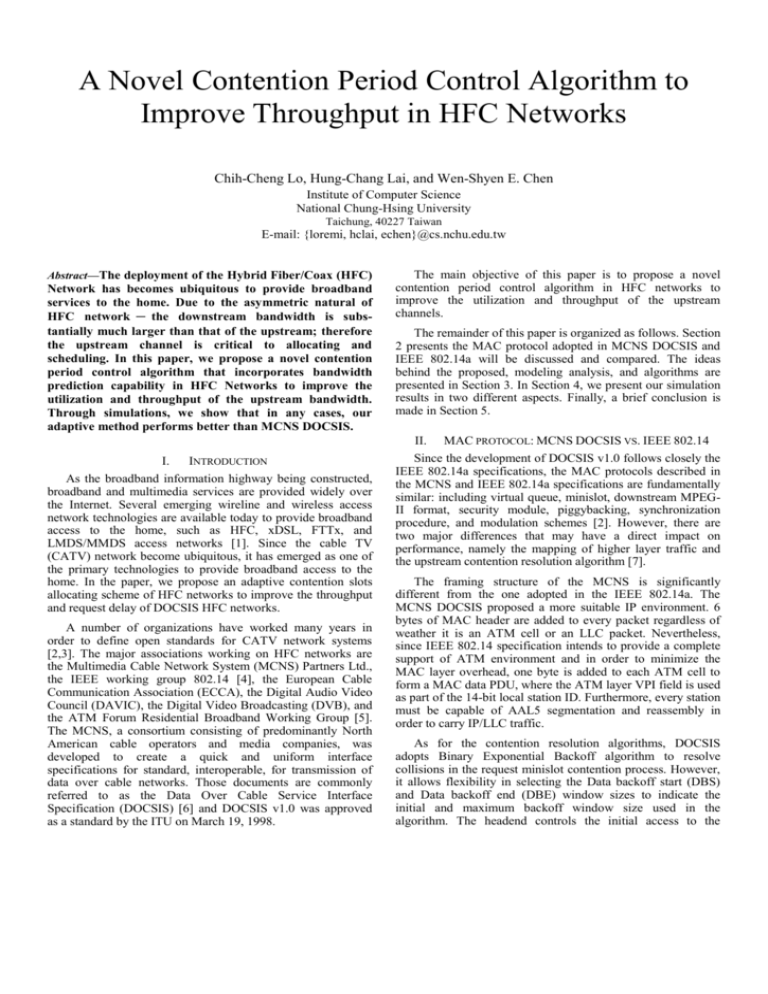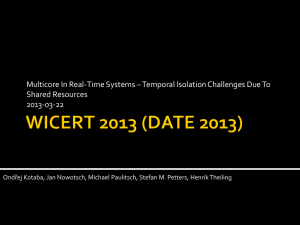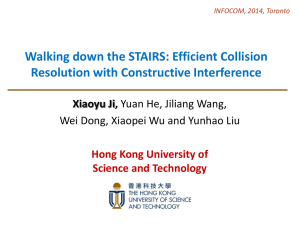III. Adaptive contention period control algorithm
advertisement

A Novel Contention Period Control Algorithm to
Improve Throughput in HFC Networks
Chih-Cheng Lo, Hung-Chang Lai, and Wen-Shyen E. Chen
Institute of Computer Science
National Chung-Hsing University
Taichung, 40227 Taiwan
E-mail: {loremi, hclai, echen}@cs.nchu.edu.tw
Abstract—The deployment of the Hybrid Fiber/Coax (HFC)
Network has becomes ubiquitous to provide broadband
services to the home. Due to the asymmetric natural of
HFC network - the downstream bandwidth is substantially much larger than that of the upstream; therefore
the upstream channel is critical to allocating and
scheduling. In this paper, we propose a novel contention
period control algorithm that incorporates bandwidth
prediction capability in HFC Networks to improve the
utilization and throughput of the upstream bandwidth.
Through simulations, we show that in any cases, our
adaptive method performs better than MCNS DOCSIS.
The main objective of this paper is to propose a novel
contention period control algorithm in HFC networks to
improve the utilization and throughput of the upstream
channels.
The remainder of this paper is organized as follows. Section
2 presents the MAC protocol adopted in MCNS DOCSIS and
IEEE 802.14a will be discussed and compared. The ideas
behind the proposed, modeling analysis, and algorithms are
presented in Section 3. In Section 4, we present our simulation
results in two different aspects. Finally, a brief conclusion is
made in Section 5.
II.
I.
INTRODUCTION
As the broadband information highway being constructed,
broadband and multimedia services are provided widely over
the Internet. Several emerging wireline and wireless access
network technologies are available today to provide broadband
access to the home, such as HFC, xDSL, FTTx, and
LMDS/MMDS access networks [1]. Since the cable TV
(CATV) network become ubiquitous, it has emerged as one of
the primary technologies to provide broadband access to the
home. In the paper, we propose an adaptive contention slots
allocating scheme of HFC networks to improve the throughput
and request delay of DOCSIS HFC networks.
A number of organizations have worked many years in
order to define open standards for CATV network systems
[2,3]. The major associations working on HFC networks are
the Multimedia Cable Network System (MCNS) Partners Ltd.,
the IEEE working group 802.14 [4], the European Cable
Communication Association (ECCA), the Digital Audio Video
Council (DAVIC), the Digital Video Broadcasting (DVB), and
the ATM Forum Residential Broadband Working Group [5].
The MCNS, a consortium consisting of predominantly North
American cable operators and media companies, was
developed to create a quick and uniform interface
specifications for standard, interoperable, for transmission of
data over cable networks. Those documents are commonly
referred to as the Data Over Cable Service Interface
Specification (DOCSIS) [6] and DOCSIS v1.0 was approved
as a standard by the ITU on March 19, 1998.
MAC PROTOCOL: MCNS DOCSIS VS. IEEE 802.14
Since the development of DOCSIS v1.0 follows closely the
IEEE 802.14a specifications, the MAC protocols described in
the MCNS and IEEE 802.14a specifications are fundamentally
similar: including virtual queue, minislot, downstream MPEGII format, security module, piggybacking, synchronization
procedure, and modulation schemes [2]. However, there are
two major differences that may have a direct impact on
performance, namely the mapping of higher layer traffic and
the upstream contention resolution algorithm [7].
The framing structure of the MCNS is significantly
different from the one adopted in the IEEE 802.14a. The
MCNS DOCSIS proposed a more suitable IP environment. 6
bytes of MAC header are added to every packet regardless of
weather it is an ATM cell or an LLC packet. Nevertheless,
since IEEE 802.14 specification intends to provide a complete
support of ATM environment and in order to minimize the
MAC layer overhead, one byte is added to each ATM cell to
form a MAC data PDU, where the ATM layer VPI field is used
as part of the 14-bit local station ID. Furthermore, every station
must be capable of AAL5 segmentation and reassembly in
order to carry IP/LLC traffic.
As for the contention resolution algorithms, DOCSIS
adopts Binary Exponential Backoff algorithm to resolve
collisions in the request minislot contention process. However,
it allows flexibility in selecting the Data backoff start (DBS)
and Data backoff end (DBE) window sizes to indicate the
initial and maximum backoff window size used in the
algorithm. The headend controls the initial access to the
contention slot by setting Data backoff start and Date backoff
end.
When a station has data to send, it sets its internal backoff
windows according to the data backoff range indicate in the
allocation MAP. The random value means the number of
contention transmit opportunities, which the station must defer
before transmitting. The station then randomly selects a
number within the backoff range and sends out its request.
Since station cannot detect whether it is collision or not, it
should wait the headend sends feedback either a Data Grant or
an Acknowledgement (Ack) in a subsequent allocation MAP.
If station does not receive either Data Grant or Ack in the
subsequent allocation MAP, it indicates that a collision has
occurred. However the headend does not need to send an
explicit feedback message on the status of each contention slot
as in the IEEE 802.14a specifications. In this case, the station
must then increase its backoff windows by a factor of two as
long as it is less than the Data backoff end value set in the
allocation MAP. Once again, the station randomly selects a
number within its new window range and repeats the
contention process depicted above. After 16 unsuccessful
retries, the station discards the MAC PDU.
The collision resolution algorithm in the IEEE 802.14a
consists of two parts. The first part is the first transmission
rules that adopt priority plus FIFO algorithm designed for
newcomers, while the second part is the retransmission rule
that adopts n-ary tree plus p-persistent algorithm designed for
collide requests. The headend controls the initial access to the
contention slots and manages the Contention Resolution
Protocol (CRP) by assigning a Request Queue (RQ) number to
each contention slot. When a data packet is received, the
station generates a Request Minislot Data Unit (RMDU). The
headend controls the stations entry by sending an Admission
Time Boundary (ATB) periodically. Only stations that
generated RMDU time before ATB are eligible to enter the
contention process. Once the RMDU is generated, the station
waits for a CS allocation message from the headend that
reserves a group of CS with RQ = 0 for newcomer
transmission. As upstream channel is shared media, multiple
stations may attempt to send their requests simultaneously and
a collision may occur. A feedback message is sent by the
headend to the station after a roundtrip time to inform the status
of the contention slots. With a successful request transmission,
a Data Grant message will be sent by the headend and the
station activates its data transmission state machine. In case of
collision, the feedback message contains a particular RQ value
to inform those stations involved. The stations need to
retransmit their requests within the specific contention slot
group that contains the equal RQ value. The contention slot
groups are usually allocated in the order of decreasing RQ
values. For each RQ value the headend assigns a group of
contention slots and associated splitting value (SPL) that is
default to three, i.e., IEEE 802.14a adopts 3-ary tree algorithm
to process contention.
III.
ADAPTIVE CONTENTION PERIOD CONTROL ALGORITHM
In this section, we propose an adaptive contention period
control scheme to predict the number of contention slots in
order to better cope with the request contention and to provide
a better system performance. Some papers have studied this
topic [8-12] but we further improve the concepts with some
novel approaches. The main idea behind our proposed method
is to dynamically adjust the number of contention slots to meet
the number of requests arriving at the system, and to achieve
the maximum bandwidth throughput and minimum request
delay time. We first analyze the probability of contention, and
then derive the bandwidth utilization and predict the reserved
number of contention minislots. Finally, we propose a new
adaptive method to dynamically adjust the number of
contention slots to realize our ideas.
A. Investigation each state’s probability of CS
For each contention minislot (CS) in the upstream
direction, there have only three states, Idle, Success, or
Collision. It is intuitive that we should expect more Success
slots but less Idle and Collision slots, as the latter two cases
will waste the bandwidth.
The following shows how we derive the probability of
those three cases. Suppose we have m minislots and n requests,
where m and n denote the number of contention slots and the
number of requests, respectively. Then we can derive the total
combinations of the permutation as:
n
m 1
n
(1)
And the combinations of the permutation if there is only
one empty minislot and exactly one monislot has been selected
by one request were shown in equations (2) and (3),
respectively.
n ( m 1) 1
(2)
n
( n 1) ( m 1) 1
(3)
n 1
Based on the aforementioned formulas, we can derive the
probability of Idle slots, Success slots, and Collision slots as
shown in equations (4), (5), and (6), respectively.
n m 2
( ( n m 2)! )
n
( 2)
n!( m 2)! m 1
(1)
n m 1 ( ( n m 1)! ) n m 1
n!( m 1)!
n
n m 3
( n m 3)!
(
)
(3) n 1
n( m 1)
( n 1)! ( m 2)!
(
n
m
1
)!
n
m
1
(1)
( n m 1)( n m 2)
(
)
n
!
(
m
1
)!
n
(4)
(5)
and 1 (4) (5)
1
m 1
n m 1
n ( m 1)
( n m 1)( n m 2)
n ( n 1)
( n m 1)( n m 2)
(6)
The objective of our proposed scheme is to reserve the
appropriate number of contention slots that meet the maximum
success probability when n number of requests had arrived,
such that, we can take differentiation of the equation (5) with
respect to m, and find out the maximum value of m, as shown
in equation (7). From (7), we obtain that m approximates n, i.e.,
if there are number of n requests arrives, the system should
reserve m contention slots to achieve the maximum success
probability.
m
n ( n 1) 1
(7)
B. Adaptive contention slots control algorithm
After analyzing the value of maximized success probability,
we will discuss how to dynamically adjust the contention slots
based on the previous probability of idle/success/collision. The
idea is to make the appropriate number of the contention slots
predictable. To illustrate this point, we first define the
following notations to depict our algorithms:
Dmap: time between the CMTS starts transmitting a MAP and
when the MAP goes into effect
Np: the request had been received by CMTS successfully but
have not allocate data slot yet
Ncm: total number of CMs in this HFC networks
Pidle: the probability of slot as idle state in the previously
contention slot
Psuccess: the probability of slot as success state in the
previously contention slot
Pcollision: the probability of slot as collision state in the
previously contention slot
Tidle: the threshold of idle state’s probability
Tsuccess: the threshold of success state’s probability
Tcollision: the threshold of collision state’s probability
Npc: the number of contention slots in previously competition
Nc: the number of contention slots in this cycle’s competition
Nmax: the maximum number of contention slots
Nmin: the minimum number of contention slots
Weight: the weighting value
We can derive from above discussion that the range of
contention slots number must be between the following two
numbers:
Nmax = Ncm - Np
Nmin = Dmap
Since our prediction concept is to observe the previous
probability of success/collision and whether that reserved
minislots are suitable or not as the basis. Nevertheless, not only
previous basis, we also have to include a set of thresholds as
the adjusting foundation. The set of thresholds values (idle,
success, collision) in our simulation is (45%, 40%, 35%). The
objective of weighting function is to accelerate the adjustment
of the number of collision slots when the probability of
collision is greater than the successes. Based on these concepts,
we can derive our algorithms for different conditions as
follows:
if (Pcollision > Psuccess)
weight++;
else
weight = 0;
If ( Pcollision > Tcollision )
{
if ( weight > 2)
Nc = Ncm – Np; // set to maximum value
else
Nc = Npc + max(Dmap, Npc)*weight;
};
If ( Pidle > Tidle )
Nc = Npc – (Npc*Pidle – Npc*Psuccess) ;
If ( Psuccess > Tsucces )
Nc = Npc ;
IV.
SIMULATION RESULTS
In this section, we will compare our method with DOCSIS
specification and point out the difference. For practicality, we
measure the throughput, request delay, and drop numbers of
the simulated system, in which throughput is defined as how
much data (in Mbps) can be transmitted in a unit time period.
The request delay is the time it receives a transmission
acknowledgement by the headend from the time the request
arrives at the station. We assume that data arrives at the MAC
layer of a station is small enough to fit into a single data slot.
The request delay includes the waiting time for a newcomer
slot, delays due to collision resolution, scheduling delay of a
grant message at the headend, and transmission delay of the
data slot. The drop number is the amount of packets dropped
by the queue of a cable modem. In general, a packet is dropped
when the buffers of CM is full or the retry number due to
collision is greater then the upper bound, i.e., 16.
As most of the subscribers are attached at the leave nodes
of the HFC networks, we assume that all of them have the
same distance from the headend, and all have the Poisson
arrival rate . The following, we discuss the simulation
studies of the proposed mechanism in two aspects. The first
one fixes the number of CMs, but varies the offered load,
throughput, and request delay. The other group fixes the
offered load, but varies with the number of CMs, throughput,
request delay, and drop number. Fig. 1 shows the results of the
simulation for the first aspect discussed above.
As observed in Fig. 1, when the offered load is less than
1.28 Mbps, there is no difference between our method and
DOCSIS. But when the offered load is greater then 1.28 Mbps,
the difference becomes significant gradually. Another
checkpoint is when the offered load reaches 1.44 Mbps, the
throughput does not change after that value. As a result, that
point can be viewed as the watershed to saturation state. Before
that point, our adaptive scheme obtains a better throughput than
DOCSIS for about 7%.
Compare, Packet size 64Bytes, CMs 50
Throughput
(Mbps)
There is an interesting phenomenon, i.e., when the
difference between the proposed method and DOCSIS in
request delay is small, the difference in drop number becomes
larger. But, when the difference between our method and
DOCSIS in request delay gets larger, then the difference in
drop number gets smaller.
1.4
1.2
1
0.8
0.6
0.96
1.28
1.6
1.92
2.24
2.56
Offered load (Mbps)
Throughput(adaptive)
Throughput(DOCSIS)
We depict the simulation result with a fixed offered load in
Fig. 3. As we have seen in the previous figures, when offered
load is less then 1.44 Mbps, there are almost no difference
between our methods and DOCSIS. But when offered load gets
larger than 1.44 Mbps, there is about 7% difference between
them.
(a)
Throughput
Compare, Packet size 64Bytes, CMs 600
(Mbps)
1.4
1.2
1
0.8
0.6
0.96
1.28
1.6
1.92
2.24
When offered load goes below 1.28 Mbps, the increase is
smoothly. While if offered load goes over that point, the
request delay will take off sharply until the offered load
reaches 1.44 Mbps, and the increasing will about 9 times of
original value. After 1.44 Mbps, the curve becomes stabilized.
Let’s observe the other parameter: the drop number stays close
to zero when offered load is less than 1.28 Mbps, but it
increases substantially when offered load becomes greater.
2.56
Offered load (Mbps)
Throughput(adaptive)
Throughput (Mbps)
Throughput(DOCSIS)
(b)
Figure 1. The relationship between throughput and offered load.
(a) CMs = 50 (b) CMs = 600
The other comparisons are the relationship between request
delays, drop number and offered load. As shown in Fig. 2, the
number of CMs is fixed at 50 and 600, but request delay,
offered load, and drop number are variables. In Fig. 2, the solid
line represents the request delay, while the dotted line
represents the drop packet numbers. In the request delay item,
the curve tendency of our method is similar to that of
DOCSIS.
400000
16000
300000
12000
200000
8000
100000
4000
0
0
1.28
1.6
1.92
2.24
150
250
2.56
350
450
550
CMs
Throughput(adaptive)
throughput(DOCSIS)
(a)
Throughput (Mbps)
Compare, packet size 64 Bytes, Offered load 2.72Mbps
1.4
1.28
1.16
1.04
0.92
0.8
150
250
350
450
550
CMs
number
20000
0.96
50
50
Compare, Packet size 64Bytes, CMs 50
delay(usec)
Compare, packet size 64 Bytes, Offered load 0.96Mbps
1.2
1.1
1
0.9
0.8
0.7
0.6
Throughput(adaptive)
throughput(DOCSIS)
(b)
Figure 3. The relationship between throughput and offered load
(a) offered load = 0.96 (b) offered load = 2.72
Offered Load (Mbps)
request delay(adaptive)
drop count(adaptive)
request delay(DOCSIS)
drop count(DOCSIS)
(a)
Compare, Packet size 64Bytes, CMs 600
delay(usec)
number
250000
300000
200000
225000
150000
150000
100000
75000
50000
0
0
0.96
1.28
1.6
1.92
2.24
2.56
Offered Load (Mbps)
request delay(adaptive)
request delay(DOCSIS)
drop count(adaptive)
drop count(DOCSIS)
(b)
Figure 2. The relationship between request delay, drop number
and offered load. (a) CMs = 50 (b) CMs = 600
In the last set of simulations, we focus on the the
relationship between request delay, drop number, and the
number of CMs while fixed the offered load. Again, the solid
line represents the request delay, while the dotted line
represents the drop packet numbers.
As shown in Fig. 4, when offered load is less than 1.28
Mbps, our method is about 20% to 50% better than DOCSIS,
in terms of request delay. But the difference diminishes when
offered load becomes greater than 1.44 Mbps. Nevertheless,
when the offered load is light, the drop numbers of both
methods are almost zero. Whereas, when the offered load
gradually increases and exceeds 1.44 Mbps, the drop packet
number increases dramatically, especially in DOCSIS case.
Compare, packet size 64Bytes, Offered load 0.96Mbps
Delay
(usec)
number
12500
10000
10000
7500
8000
6000
5000
2500
4000
2000
0
0
50
150
250
350
450
550
CMs
request delay(adaptive)
request delay(DOCSIS)
drop count(adaptive)
drop count(DOCSIS)
(a)
Compare, packet size 64Bytes, Offered load 1.28Mbps
Delay
(usec)
number
35000
20000
28000
16000
21000
12000
14000
8000
7000
4000
0
0
50
150
250
350
CMs
request delay(adaptive)
drop count(adaptive)
450
550
request delay(DOCSIS)
drop count(DOCSIS)
(b)
Compare, packet size 64Bytes, Offered load 1.44Mbps
Delay
number
(usec)
240000
50000
40000
30000
20000
10000
0
180000
120000
60000
0
50
150
250
350
CMs
request delay(adaptive)
drop count(adaptive)
450
550
request delay(DOCSIS)
drop count(DOCSIS)
(c)
Compare, packet size 64Bytes, Offered load 2.72Mbps
Delay
(usec)
number
240000
300000
180000
280000
120000
260000
60000
240000
0
220000
50
150
250
CMs 350
450
550
request delay(adaptive)
request delay(DOCSIS)
drop count(adaptive)
drop count(DOCSIS)
(d)
Figure 4. The relationship between request delay, drop number and
offered load. (a) offered load=0.96 Mbps (b) offered load=1.28Mbps
(c) offered load=1.44 Mbps (d) offered load=2.72Mbps
V.
CONCLUSION
In this paper, we have presented the architecture of the
HFC networks and pointed out the upstream channel is the
critical factor that dramatically affects the network
performance and the channel access allocation mechanism is
very important in improving the overall throughput. We
proposed an adaptive contention period control to predict the
suitable number of contention slots to meet the request
numbers arriving at the system; i.e., if there are n arriving
requests, then the system should reserve m contention slots to
achieve the maximum success probability. We also evaluated
the performance of the system we proposed in two different
aspects by simulations. From the obtained results, we conclude
that the proposed adaptive method has a better performance
than that of MCNS DOCSIS in the cases studied.
REFERENCES
[1]
[2]
Gorge Abe, Residential Broadband, 2nd Edition, Cisco Press, 2000.
Y. D. Lin, W. M. Yin, and C. Y Huang, “An Investigation into HFC
MAC Protocols: Mechanisms, Implementation, and Research Issues,”
IEEE Communications Surveys, PP. 2-13, Third Quarter 2000.
[3] V. Sdralia, C. Smythe, P. Tzerefos, and S. Cvetkovic, “Performance
Characterisation of the MCNS DOCSIS 1.0 CATV Protocol with
Prioritised First Come First Served Scheduling,” IEEE Trans.
Broadcasting, vol. 45, no. 2, pp. 196-205, Jun. 1999.
[4] IEEE IEEE project 802.14/a, Draft 3, Revision 1, Apr. 1998.
[5] Residential Broadband Architecture Framework, ATM Forum Technical
Committee, AF-RBB-0099.000, Jul 1998. 001.
[6] Cable Television Laboratories, Inc., Data-Over-Cable Service Interface
Specifications-Radio Frequency Interface Specification, Version 2.0,
Nov. 2
[7] N. Glomie, F. Mouveaux, and D. Su, “A Comparison of MAC Protocols
for Hybrid Fiber/Coax Networks: IEEE 802.14 vs. MCNS,” Proc. ICC
1999, pp. 266-272, 1999.
[8] D. Sala, J. O. Limb, “A Protocol for Efficient Transfer of Data over
Fiber/Cable Systems,” IEEE Trans. on Networking, vol. 5, no. 6, Dec.
1997.
[9] N. Glomie, Y. Saintillan, and D. Su, “A Review of Contention
Resolution Algorithms for IEEE 802.14 Networks,” IEEE
Communications Surveys, PP. 2-12, First Quarter 1999.
[10] Y. D. Lin, C. Y Huang, and W. M. Yin, “Allocation and Scheduling
Algorithms for IEEE 802.14 and MCNS in Hybrid Fiber Coaxial
Networks,” IEEE Trans. on Broadcasting, vol. 44, pp. 427-435, Dec.
1998.
[11] W. M. Yin, and Y. D. Lin, “Statistically Optimized Minislot Allocation
for Initial and Collision Resolution in Hybrid Fiber Coaxial Networks,”
IEEE Journasl on Select Area in Commun., vol. 18, no. 19, pp. 17641773, Sep. 2000.
[12] M. D. Corner, J. Libeherr, N. Golmie, C. Bisdikian, and D. H. Su, “A
Priority Scheme for the IEEE 802.14 MAC Protocol for Hybrid FiberCoax Networks,” IEEE/ACM Trans. on Networking, vol. 8, no. 2, pp.
200-211, Apr. 2000.








